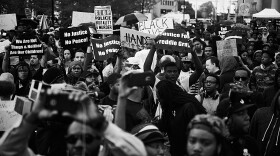This time 10 years ago, politicians promised money and revitalization to the West Baltimore neighborhood of Sandtown-Winchester.
That came after the Baltimore Uprising, spurred by the death of Sandtown resident Freddie Gray following injuries he suffered while in police custody.
Though she turns her phone to silent, the screen on LeChelle Redd’s device barely goes dark as calls come in during our ten-minute interview. She’s executive director at Faith and Work Enterprises, a relief-based Christian nonprofit at the corner of Stricker and Presstman, and gets requests for help 8, 12, 14 hours of the day.
“Eviction prevention, BGE assistance, case management… mental health,” she rattles off a list of resources people come to her for when they need help.

Half of the area’s children still live in poverty; the rate of vacant homes and lots is four times the citywide average. State lawmakers have passed bills totaling hundreds of millions of dollars for revitalization on projects that ended up outside Sandtown. Redd doesn’t see any signs of investment.
“There are no new trees, no new buildings, no new businesses,” says Redd, who grew up in the area during the 80’s and 90’s before getting a scholarship to Towson University. “No new nothing. That's pretty scary. Things change. I was just 10 pounds lighter a couple of months ago. Now I'm 10 pounds heavier. Things change, and if they don't, we have to begin to ask ourselves: why?”

Todd Marcus is a co-founder at Intersection of Change, a West Baltimore anti-poverty nonprofit. He sees positive movement but agrees that change isn’t happening fast enough.
“The pressing issues are the same things that led to the unrest after the death of Martin Luther King in 1968; it's the same inequities, concentration of poverty, racial disparities.”
Pastor Rodney Hudson sees some ways in which the Sandtown-Winchester neighborhood has improved. Children play at the Cumberland and Carey Playground where parents keep a watchful but relaxed eye. He walks me down Carey Street on a warm but windy evening, pointing to each street corner.
“You couldn’t walk down these corners without seeing a drug dealer. You’d see 10,12 guys on these corners.”
The corners are empty, even at sunset. We head towards Baker and Carey Streets, where Hudson had his old church and where over a decade ago, Freddie Gray and his friends used to sell drugs. Hudson used to preach on a megaphone to make the dealers move so parishioners could go to Sunday services in comfort.
“I had a member who lived right there in that house. I took the extension cord and brought my speaker out and started playing the music and preaching. And so — this is a true story — they called the police on me. The drug dealers called the police on me, and they told me I had to move because I was disturbing the peace,” he recounts.

Hudson tells me this to show how some aspects of the neighborhood have gotten safer, which he credits to tandem efforts between the police and community members. But, he doesn’t condemn Freddie Gray.
“But he was not a disrespectful young man at all. He was just trying to survive, and the culture at that time would not let him survive the way he could have survived, because the economics of our community, because of the addictions that have plagued our community, were not addressed soon enough.”
And that’s why Hudson says the community has to keep pushing forward.
“What we're trying to prevent is the senseless dying of other Freddie Grays.”











